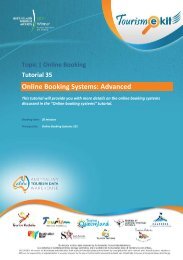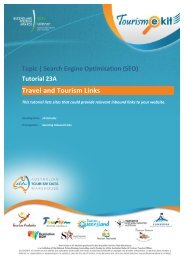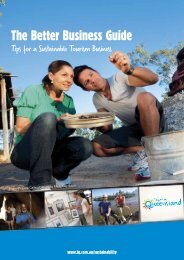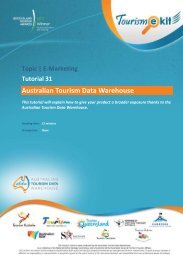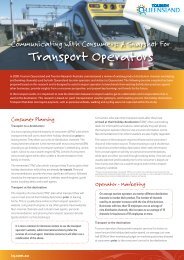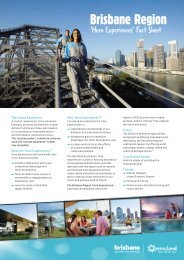Section 1: Introduction - Tourism Queensland
Section 1: Introduction - Tourism Queensland
Section 1: Introduction - Tourism Queensland
You also want an ePaper? Increase the reach of your titles
YUMPU automatically turns print PDFs into web optimized ePapers that Google loves.
INTRODUCTION | Writing your marketing plan<br />
Once you start writing the plan, it’s a good idea to avoid making it into some dreary<br />
document that sits on a shelf gathering dust. Below are some simple tips that will<br />
help you keep your plan real and relevant.<br />
Planning tips<br />
1. Be realistic Consider what you can achieve in a 12-month period and<br />
what resources you need and can commit to bring your<br />
plans to life. Resources include financial capacity, time and<br />
energy, and staff capability<br />
2. Keep it<br />
simple<br />
Be concise. Your plan should be short, easy to follow and to<br />
the point<br />
3. Prioritise Decide what you must do first and let the rest follow<br />
4. Cover your<br />
bases<br />
Set goals so you cover improvements to all key areas of<br />
the business. One goal for each part of the marketing mix<br />
might be a good way to start<br />
5. Include<br />
quick wins<br />
Set your goals so you achieve some quick wins as well as<br />
mid and longer term results<br />
The plan in detail<br />
So far, we’ve covered the concepts of a marketing plan from a high-level<br />
perspective. Now we’ll go through each stage and more fully explain the terms<br />
and their meanings, and how to apply your knowledge to create a plan that’s<br />
meaningful to your everyday operations.<br />
Business Profile<br />
This section is the preamble to your<br />
planning. It sets the parameters for<br />
your Action Plan.<br />
Describe your business and what<br />
services you deliver. Keep it brief and<br />
to the point – a few sentences should<br />
do it. This will be followed by your<br />
Mission or Vision Statement, Goals and<br />
Competitive Advantages.<br />
The Vision or Mission is a very short<br />
affirmation statement, not usually more<br />
than 10 words. An example might be:<br />
‘SceneXtreme is the Number One tour<br />
experience in <strong>Queensland</strong>’<br />
You can use the statement to guide<br />
what activities you take on by asking,<br />
‘Will this activity help SceneXtreme<br />
Tours to become the number one tour<br />
experience in <strong>Queensland</strong>?’ If the<br />
answer is no, you know not to do it<br />
and to spend your resources on other<br />
activities that will help you to achieve<br />
your Mission or Vision.<br />
Once you have a clear Vision of<br />
where you’re taking the business, you<br />
can develop some goals to help you<br />
get there.<br />
Your Goals should focus on improving<br />
your marketing advantage across all<br />
key aspects of the business. A helpful<br />
way to start might be to look at the five<br />
Ps and develop one goal for each P.<br />
The Goals underpin the Action Plan.<br />
Later in the plan you will develop<br />
strategies, activities, measures and<br />
allocate a budget to achieve each goal.<br />
THE BIG MARKETING GUIDE<br />
7




